A Study of R-R Interval Transition Matrix Features for Machine Learning Algorithms in AFib Detection
Abstract
1. Introduction
1.1. Background
1.2. Related Work
1.3. Contribution
- Feeding a total of 21 features, including 8 innovative transition matrix features, into 11 machine learning classifiers, and systematically comparing the classifier outputs to determine the most effective models for AFib detection.
- Using two feature importance methods, including the permutation feature importance and tree-based feature importance, to obtain the most significant and predictive features in AFib detection.
- Incorporating three segmentation schemes of 5 s, 10 s, and 25 s to examine the effect of different segment lengths on classifier performance and feature importance results.
2. Exploratory Data Analysis and Preprocessing on MIT-BIH
2.1. MIT-BIH Atrial Fibrillation Database
2.2. Single-Subject Analysis
2.3. Outlier Removal
2.4. Rhythm Differentiation
3. Features
3.1. Transition Matrix Features
3.2. RR Variance
3.3.
3.4. Root Mean Square of the Successive Differences
3.5. Standard Deviation
3.6. Median Absolute Deviation (MAD)
3.7. Coefficient of Variance (CoefVar)
3.8. Interquartile Range and Range
3.9. Gini Index
3.10. Poincare Plot Distance
3.11. Entropy Features
3.11.1. Approximate Entropy
3.11.2. Sample Entropy
3.11.3. Shannon Entropy
3.12. Features across AFib and Non-AFib Classes
4. Classifiers
4.1. Non-Tree Based Classifiers
4.2. Tree-Based Classifiers
4.3. Hyperparameter Tuning
4.4. Leave-One-Person-Out Cross Validation
4.5. Metrics
5. Feature Importance
6. Experiment Results
6.1. Overall Model Performance for Three Segmentation Schemes
6.2. Comparison of Model Performance across Three Segmentation Schemes
6.3. Comparison of Actual Rhythms and XGBoost Classification Performance
6.4. Feature Importance Results for Three Segmentation Schemes
6.5. Feature Prevalence Results in the Top Five Important Features for Three Segmentation Schemes
6.6. Feature Importance Results for the Proposed Transition Matrix Features
7. Discussion
7.1. Principal Finding
7.2. Future Work
8. Conclusions
Author Contributions
Funding
Institutional Review Board Statement
Informed Consent Statement
Data Availability Statement
Acknowledgments
Conflicts of Interest
Abbreviations
| AFib | Atrial Fibrillation |
| AUC | Area Under Curve |
| LogReg | Logistic Regression |
| LDA | Linear Discriminant Analysis |
| QDA | Quadratic Discriminant Analysis |
| KNN-CV | K-Nearest Neighbors Cross Validation |
| AdaBoost | Adaptive Boosting |
| GBM | Gradient Boosting |
| LGBoost | Light Gradient Boosting |
| XGBoost | Extreme Gradient Boosting |
| MAD | Median Absolute Deviaion |
| IQR | Interquartile Range |
| STD | Standard Deviation |
| CoefVar | Coefficient of Variance |
| SampEn | Sample Entropy |
| ApEn | Approximate Entropy |
| ShanEn | Shannon Entropy |
References
- Keidar, N.; Elul, Y.; Schuster, A.; Yaniv, Y. Visualizing and Quantifying Irregular Heart Rate Irregularities to Identify Atrial Fibrillation Events. Front. Physiol. Card. Electrophysiol. 2021, 12, 637680. [Google Scholar] [CrossRef] [PubMed]
- Nattel, S.; Burstein, B.; Dobrev, D. Atrial remodeling and atrial fibrillation: Mechanisms and implications. Circulation. Arrhythmia Electrophysiol. 2008, 1, 62–73. [Google Scholar] [CrossRef]
- Gutierrez, C.; Blanchard, D.G. Diagnosis and Treatment of Atrial Fibrillation. Am. Fam. Physician 2016, 94, 442–452. [Google Scholar] [PubMed]
- Schillinger, K.J.; Patel, V.V. Atrial fibrillation in the elderly: The potential contribution of reactive oxygen species. J. Geriatr. Cardiol. JGC 2012, 9, 379–388. [Google Scholar] [CrossRef]
- Krijthe, B.P.; Kunst, A.; Benjamin, E.J.; Lip, G.Y.; Franco, O.H.; Hofman, A.; Witteman, J.C.; Stricker, B.H.; Heeringa, J. Projections on the number of individuals with atrial fibrillation in the European Union, from 2000 to 2060. Eur. Heart J. 2013, 34, 2746–2751. [Google Scholar] [CrossRef] [PubMed]
- Jansson, V.; Bergfeldt, L.; Schwieler, J.; Kennebäck, G.; Rubulis, A.; Jensen, S.M.; Raatikainen, P.; Sciaraffia, E.; Blomström-Lundqvist, C. Atrial fibrillation burden, episode duration and frequency in relation to quality of life in patients with implantable cardiac monitor. Int. J. Cardiol. Heart Vasc. 2021, 34, 100791. [Google Scholar] [CrossRef]
- Prystowsky, E.N.; Padanilam, B.J.; Fogel, R.I. Treatment of Atrial Fibrillation. J. Am. Med. Assoc. 2015, 314, 278–288. [Google Scholar] [CrossRef] [PubMed]
- Van Wagoner, D.R.; Nerbonne, J.M. Molecular basis of electrical remodeling in atrial fibrillation. J. Mol. Cell. Cardiol. 2000, 32, 1101–1117. [Google Scholar] [CrossRef]
- Andersson, T.; Magnuson, A.; Bryngelsson, I.L.; Frøbert, O.; Henriksson, K.M.; Edvardsson, N.; Poçi, D. All-cause mortality in 272,186 patients hospitalized with incident atrial fibrillation 1995–2008: A Swedish nationwide long-term case-control study. Eur. Heart J. 2013, 34, 1061–1067. [Google Scholar] [CrossRef]
- Rizwan, A.; Zoha, A.; Mabrouk, I.B.; Sabbour, H.M.; Al-Sumaiti, A.S.; Alomainy, A.; Imran, M.A.; Abbasi, Q.H. A Review on the State of the Art in Atrial Fibrillation Detection Enabled by Machine Learning. IEEE Rev. Biomed. Eng. 2021, 14, 219–239. [Google Scholar] [CrossRef] [PubMed]
- Olier, I.; Ortega-Martorell, S.; Pieroni, M.; Lip, G.Y. How machine learning is impacting research in atrial fibrillation: Implications for risk prediction and future management. Cardiovasc. Res. 2021, 117, 1700–1717. [Google Scholar] [CrossRef] [PubMed]
- Benito, L.; Coll-Vinent, B.; Gómez, E.; Martí, D.; Mitjavila, J.; Torres, F.; Miró, Ò.; Sisó, A.; Mont, L. EARLY: A pilot study on early diagnosis of atrial fibrillation in a primary healthcare centre. EP Europace 2015, 17, 1688–1693. [Google Scholar] [CrossRef] [PubMed]
- Li, Z.; Derksen, H.; Gryak, J.; Ghanbari, H.; Gunaratne, P.; Najarian, K. A Novel Atrial Fibrillation Prediction Algorithm Applicable to Recordings from Portable Devices. In Proceedings of the 40th Annual International Conference of the IEEE Engineering in Medicine and Biology Society (EMBC), Honolulu, HI, USA, 18–21 July 2018; pp. 4034–4037. [Google Scholar] [CrossRef]
- Lown, M.; Brown, M.; Brown, C.; Yue, A.M.; Shah, B.N.; Corbett, S.J.; Lewith, G.; Stuart, B.; Moore, M.; Little, P. Machine learning detection of Atrial Fibrillation using wearable technology. PLoS ONE 2020, 15, e0227401. [Google Scholar] [CrossRef]
- Tateno, K.; Glass, L. Automatic detection of atrial fibrillation using the coefficient of variation and density histograms of RR and deltaRR intervals. Med. Biol. Eng. Comput. 2001, 39, 664–671. [Google Scholar] [CrossRef]
- Shen, M.; Zhang, L.; Luo, X.; Xu, J. Atrial Fibrillation Detection Algorithm Based on Manual Extraction Features and Automatic Extraction Features. IOP Conf. Ser. Earth Environ. Sci. 2020, 428, 012050. [Google Scholar] [CrossRef]
- Moody, G.B.; Mark, R.G. A New Method For Detecting Atrial Fibrillation Using R-R Intervals. Comput. Cardiol. 1983, 10, 227–230. [Google Scholar]
- Khan, A.A.; Lip, G.Y.H.; Shantsila, A. Heart rate variability in atrial fibrillation: The balance between sympathetic and parasympathetic nervous system. Eur. J. Clin. Investig. 2019, 49, e13174. [Google Scholar] [CrossRef] [PubMed]
- Couceiro, R.; Carvalho, P.; Henriques, J.; Antunes, M.; Harris, M.; Habetha, J. Detection of Atrial Fibrillation Using Model-based ECG Analysis. In Proceedings of the 19th International Conference on Pattern Recognition, Tampa, FL, USA, 8–11 December 2009; pp. 1–5. [Google Scholar] [CrossRef]
- Joy Martis, R.; Acharya, U.; Prasad, H.; Chua, C.; Lim, C. Automated detection of atrial fibrillation using Bayesian paradigm. Knowl.-Based Syst. 2013, 54, 269–275. [Google Scholar] [CrossRef]
- Zhang, Y.; Zhu, J. Atrial Fibrillation Detection Based on EEMD and XGBoost. J. Phys. Conf. Ser. 2019, 1229, 012074. [Google Scholar]
- Babaeizadeh, S.; Gregg, R.E.; Helfenbein, E.D.; Lindauer, J.M.; Zhou, S.H. Improvements in atrial fibrillation detection for real-time monitoring. J. Electrocardiol. 2009, 42, 522–526. [Google Scholar] [CrossRef]
- Hirsch, G.; Jensen, S.; Poulsen, E.; Puthusserypady, S. Atrial fibrillation detection using heart rate variability and atrial activity: A hybrid approach. Expert Syst. Appl. 2021, 169, 114452. [Google Scholar] [CrossRef]
- Larburu, N.; Lopetegi, T.; Romero, I. Comparative study of algorithms for Atrial Fibrillation detection. In Proceedings of the 2011 Computing in Cardiology, Hangzhou, China, 18–21 September 2011; pp. 265–268. [Google Scholar]
- Young, B.; Brodnick, D.; Spaulding, R. A comparative study of a hidden Markov model detector for atrial fibrillation. In Proceedings of the Neural Networks for Signal Processing IX: Proceedings of the 1999 IEEE Signal Processing Society Workshop, Madison, WI, USA, 25 August 1999; pp. 468–476. [Google Scholar]
- Ghodrati, A.; Murray, B.; Marinello, S. RR interval analysis for detection of Atrial Fibrillation in ECG monitors. In Proceedings of the Annual International Conference of the IEEE Engineering in Medicine and Biology Society, Vancouver, BC, Canada, 20–25 August 2008; pp. 601–604. [Google Scholar] [CrossRef]
- Wegner, F.K.; Plagwitz, L.; Doldi, F.; Ellermann, C.; Willy, K.; Wolfes, J.; Sandmann, S.; Varghese, J.; Eckardt, L. Machine learning in the detection and management of atrial fibrillation. Clin. Res. Cardiol. 2022, 111, 1010–1017. [Google Scholar] [CrossRef] [PubMed]
- Kennedy, A.; Finlay, D.D.; Guldenring, D.; Bond, R.R.; Moran, K.; McLaughlin, J. Automated detection of atrial fibrillation using R-R intervals and multivariate-based classification. J. Electrocardiol. 2016, 49, 871–876. [Google Scholar] [CrossRef] [PubMed]
- Goodfellow, S.; Goodwin, A.; Greer, R.; Laussen, P.; Mazwi, M.; Eytan, D. Atrial fibrillation classification using step-by-step machine learning. Biomed. Phys. Eng. Express 2018, 4, 045005. [Google Scholar] [CrossRef]
- Liaqat, S.; Dashtipour, K.; Zahid, A.; Assaleh, K.; Arshad, K.; Ramzan, N. Detection of Atrial Fibrillation Using a Machine Learning Approach. Information 2020, 11, 549. [Google Scholar] [CrossRef]
- Fujita, H.; Cimr, D. Computer Aided Detection for fibrillations and flutters using deep convolutional neural network. Inf. Sci. 2019, 486, 231–239. [Google Scholar] [CrossRef]
- Acharya, U.R.; Fujita, H.; Lih, O.S.; Hagiwara, Y.; Tan, J.H.; Adam, M. Automated detection of arrhythmias using different intervals of tachycardia ECG segments with convolutional neural network. Inf. Sci. 2017, 405, 81–90. [Google Scholar] [CrossRef]
- Król-Józaga, B. Atrial fibrillation detection using convolutional neural networks on 2-dimensional representation of ECG signal. Biomed. Signal Process. Control. 2022, 74, 103470. [Google Scholar] [CrossRef]
- Chen, Y.; Zhang, C.; Liu, C.; Wang, Y.; Wan, X. Atrial Fibrillation Detection Using a Feedforward Neural Network. J. Med Biol. Eng. 2022, 42, 63–73. [Google Scholar] [CrossRef]
- Nankani, D.; Baruah, R.D. Atrial Fibrillation Classification and Prediction Explanation using Transformer Neural Network. In Proceedings of the 2022 International Joint Conference on Neural Networks (IJCNN), Padua, Italy, 18–23 July 2022; pp. 1–8. [Google Scholar]
- Mousavi, S.; Afghah, F.; Acharya, U.R. Han-ECG: An interpretable atrial fibrillation detection model using hierarchical attention networks. Comput. Biol. Med. 2020, 127, 104057. [Google Scholar] [CrossRef]
- Tison, G.H.; Zhang, J.; Delling, F.N.; Deo, R.C. Automated and Interpretable Patient ECG Profiles for Disease Detection, Tracking, and Discovery. Circ. Cardiovasc. Qual. Outcomes 2019, 12, e005289. [Google Scholar] [CrossRef] [PubMed]
- Pham, T.-H.; Sree, V.; Mapes, J.; Dua, S.; Lih, O.S.; Koh, J.E.; Ciaccio, E.J.; Acharya, U.R. A novel machine learning framework for automated detection of arrhythmias in ECG segments. J. Ambient. Intell. Humaniz. Comput. 2021, 12, 10145–10162. [Google Scholar] [CrossRef]
- Zhao, L.; Li, J.; Wan, X.; Wei, S.; Liu, C. Determination of parameters for an entropy-based atrial fibrillation detector. Entropy 2021, 23, 1199. [Google Scholar] [CrossRef]
- Altmann, A.; Toloşi, L.; Sander, O.; Lengauer, T. Permutation importance: A corrected feature importance measure. Bioinformatics 2010, 26, 1340–1347. [Google Scholar] [CrossRef]
- Goldberger, A.L.; Amaral, L.A.; Glass, L.; Hausdorff, J.M.; Ivanov, P.C.; Mark, R.G.; Mietus, J.E.; Moody, G.B.; Peng, C.K.; Stanley, H.E. PhysioBank, PhysioToolkit, and PhysioNet: Components of a new research resource for complex physiologic signals. Circulation 2000, 101, E215–E220. [Google Scholar] [CrossRef]
- Smith, G.; Wang, Y. Atrial Fibrillation Detection Using RR-Intervals for Application in Photoplethysmographs. arXiv 2023, arXiv:2302.07648. [Google Scholar]
- Farris, F.A. The Gini Index and Measures of Inequality. Am. Math. Mon. 2017, 117, 851–864. [Google Scholar] [CrossRef]
- Jeon, T.; Kim, B.; Jeon, M.; Lee, B.G. Implementation of a portable device for real-time ECG signal analysis. BioMed Eng. OnLine 2014, 13, 160. [Google Scholar] [CrossRef]
- Lake, D.; Moorman, J. Accurate estimation of entropy in very short physiological time series: The problem of atrial fibrillation detection in implanted ventricular devices. Am. J. Physiol. Heart Circ. Physiol. 2011, 300, 319–325. [Google Scholar] [CrossRef]
- Dharmaprani, D.; Dykes, L.; McGavigan, A.D.; Kuklik, P.; Pope, K.; Ganesan, A.N. Information theory and atrial fibrillation (AF): A Review. Front. Physiol. 2018, 9, 957. [Google Scholar] [CrossRef]
- Park, H.A. An introduction to logistic regression: From basic concepts to interpretation with particular attention to nursing domain. J. Korean Acad. Nurs. 2013, 43, 154–164. [Google Scholar] [CrossRef] [PubMed]
- Taunk, K.; De, S.; Verma, S.; Swetapadma, A. A Brief Review of Nearest Neighbor Algorithm for Learning and Classification. In Proceedings of the 2019 International Conference on Intelligent Computing and Control Systems (ICCS), Madurai, India, 15–17 May 2019; pp. 1255–1260. [Google Scholar] [CrossRef]
- Tharwat, A.; Gaber, T.; Ibrahim, A.; Hassanien, A. Linear discriminant analysis: A detailed tutorial. AI Commun. 2017, 30, 169–190. [Google Scholar] [CrossRef]
- Araveeporn, A. Comparing the Linear and Quadratic Discriminant Analysis of Diabetes Disease Classification Based on Data Multicollinearity. Int. J. Math. Math. Sci. 2022, 2022, 7829795. [Google Scholar] [CrossRef]
- Quinlan, J.R. Induction of decision trees. Mach. Learn. 1986, 1, 81–106. [Google Scholar] [CrossRef]
- Breiman, L. Bagging Predictors. Mach. Learn. 1996, 24, 123–140. [Google Scholar] [CrossRef]
- Breiman, L. Random Forests. Mach. Learn. 2001, 45, 5–32. [Google Scholar] [CrossRef]
- Freund, Y.; Schapire, R.E. A Short Introduction to Boosting. J. Jpn. Soc. Artif. Intell. 1999, 14, 771–780. [Google Scholar]
- Friedman, J.H. Greedy Function Approximation: A Gradient Boosting Machine. Ann. Stat. 2001, 29, 1189–1232. [Google Scholar] [CrossRef]
- Ke, G.; Meng, Q.; Finley, T.; Wang, T.; Chen, W.; Ma, W.; Ye, Q.; Liu, T.Y. LightGBM: A Highly Efficient Gradient Boosting Decision Tree. In Proceedings of the Advances in Neural Information Processing Systems, Long Beach, CA, USA, 4–9 December 2017. [Google Scholar]
- Chen, T.; Guestrin, C. XGBoost: A scalable tree boosting system. In Proceedings of the 22nd ACM SIGKDD International Conference on Knowledge Discovery and Data Mining, San Francisco, CA, USA, 13–17 August 2016. [Google Scholar]
- Sammut, C.; Webb, G.I. (Eds.) Leave-One-Out Cross-Validation. In Encyclopedia of Machine Learning; Springer: Boston, MA, USA, 2011. [Google Scholar]
- Scikit-Learn. Permutation Importance vs. Random Forest Feature Importance (MDI). Available online: https://scikit-learn.org/stable/auto_examples/inspection/plot_permutation_importance.html#sphx-glr-auto-examples-inspection-plot-permutation-importance-py (accessed on 1 September 2022).
- Clifford, G.; Liu, C.; Moody, B.; Lehman, L.; Silva, I.; Li, Q.; Johnson, A.; Mark, R. AF Classification from a Short Single Lead ECG Recording: The Physionet Computing in Cardiology Challenge 2017. Comput. Cardiol. (CinC) 2017, 44, 1–4. [Google Scholar] [CrossRef]
- Au, Q.; Herbinger, J.; Stachl, C.; Bischl, B.; Casalicchio, G. Grouped feature importance and combined features effect plot. Data Min. Knowl. Discov. 2022, 36, 1401–1450. [Google Scholar] [CrossRef]



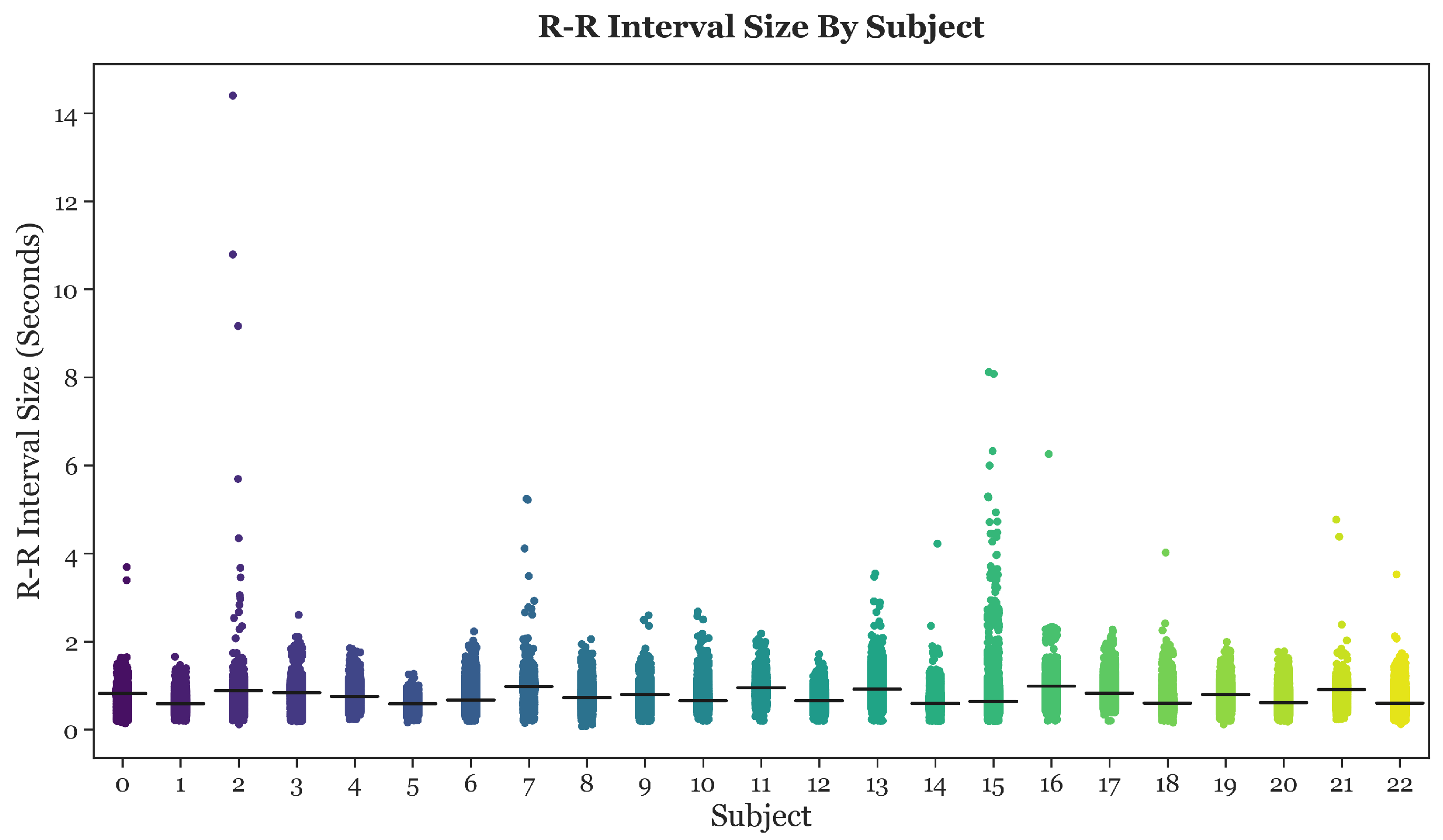


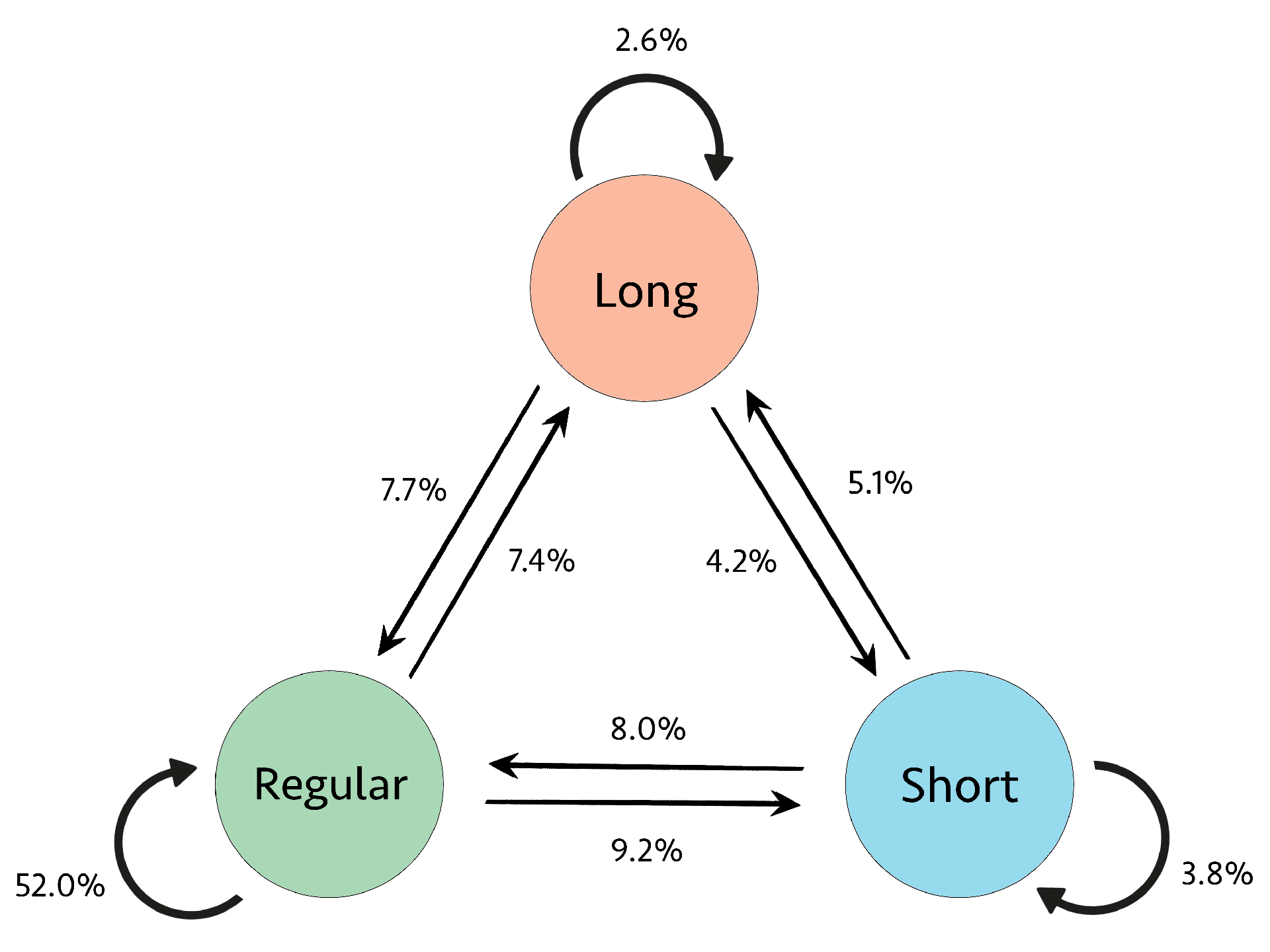

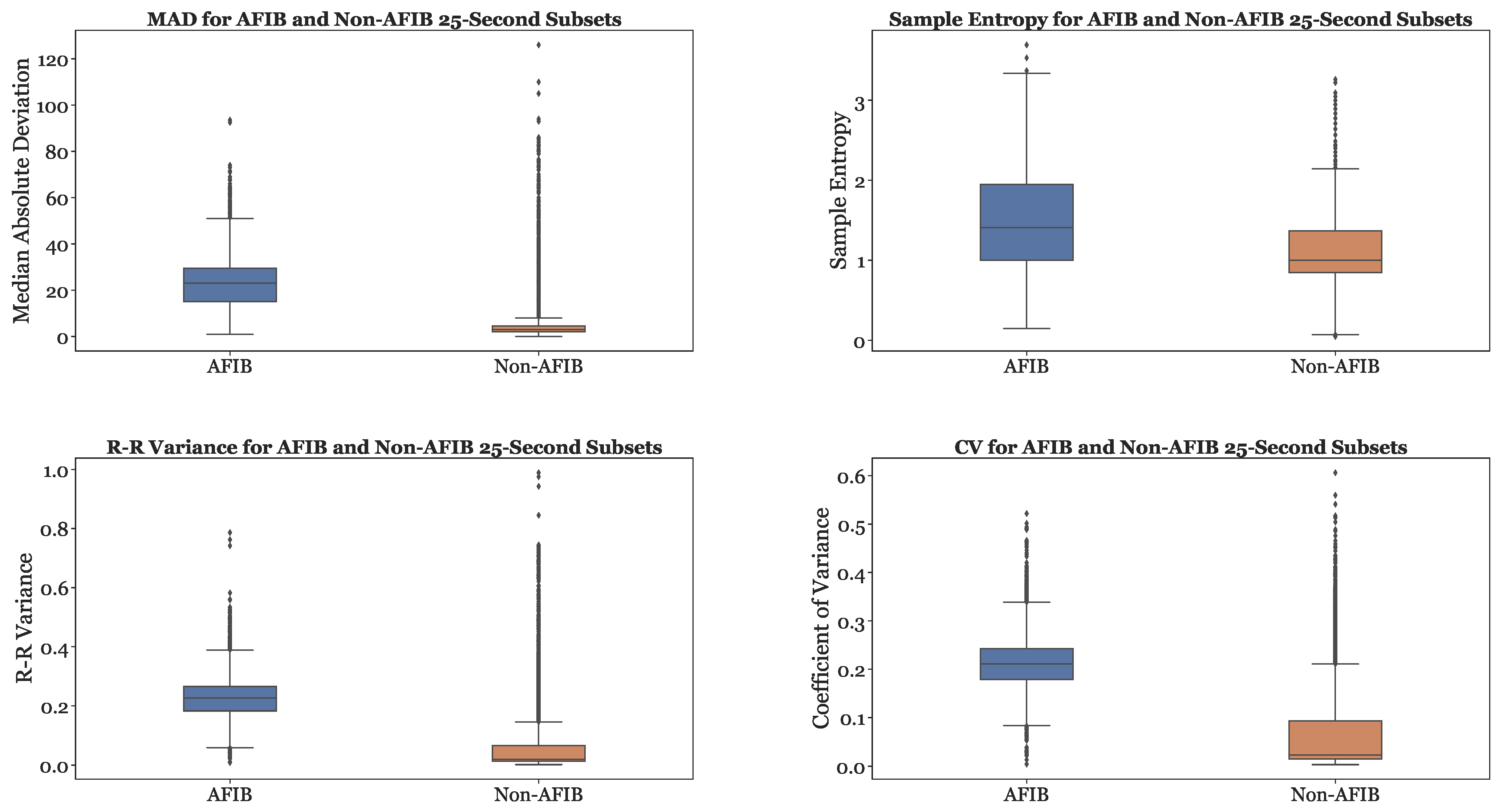
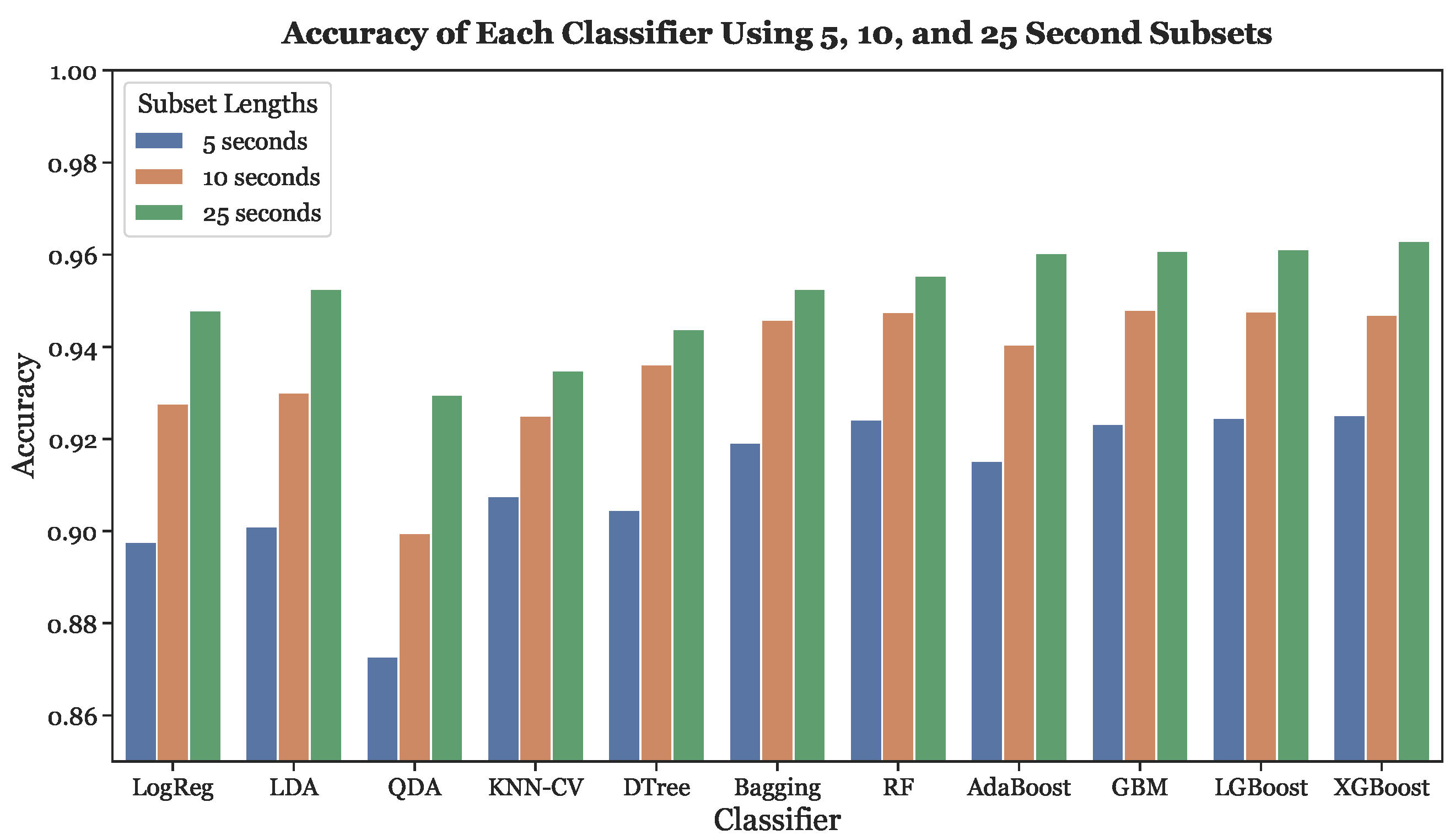

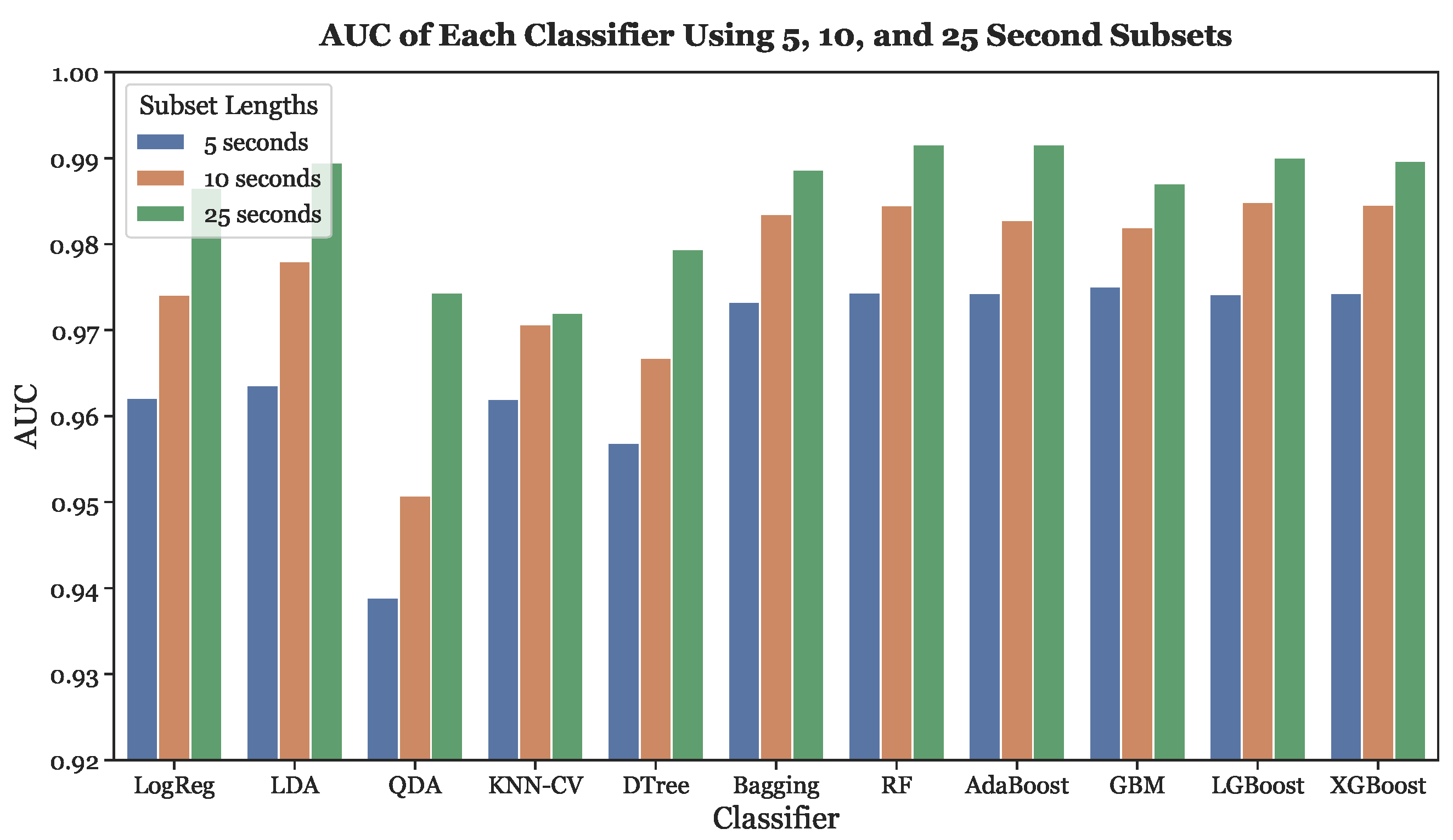


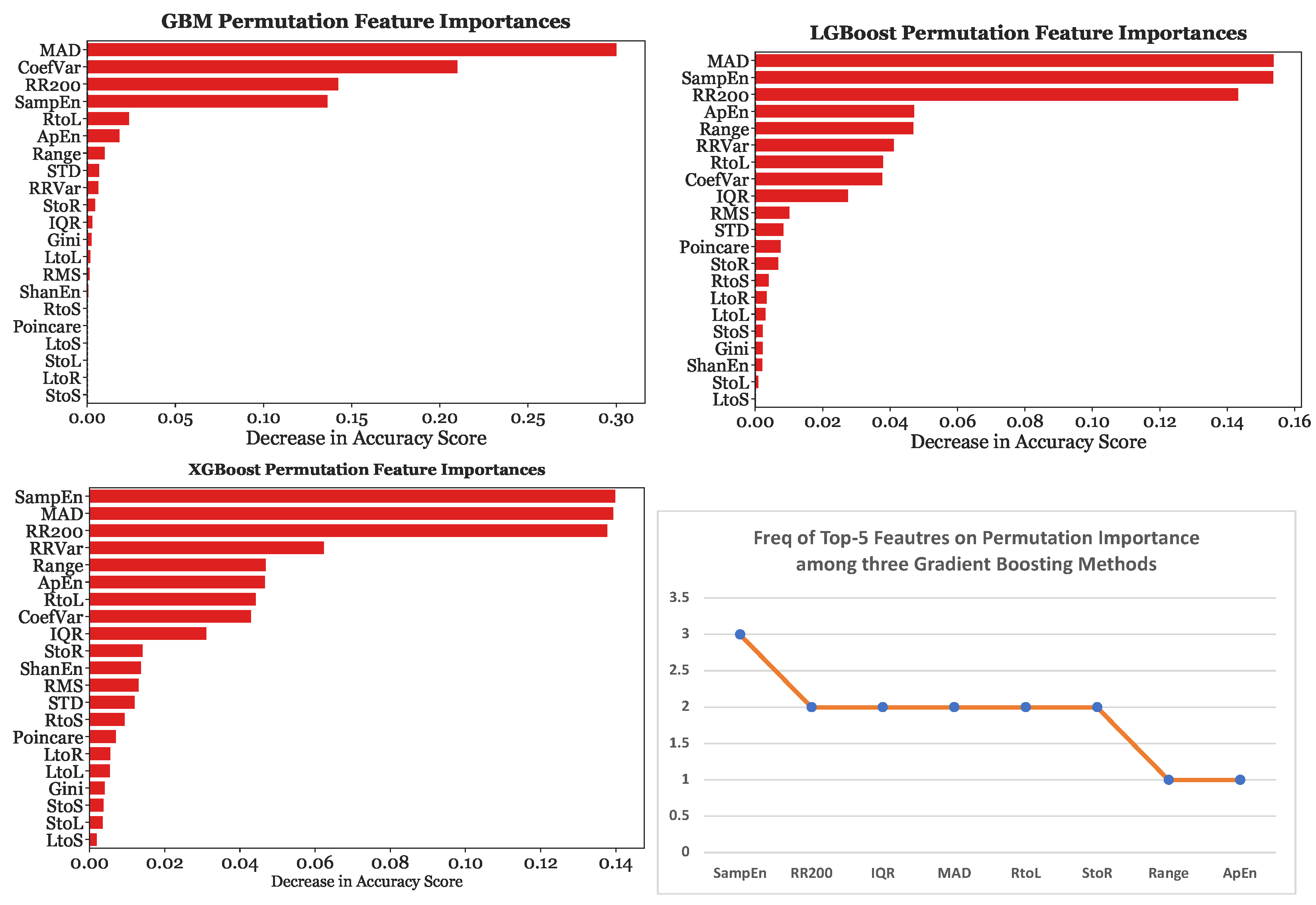

| To: | ||||
| From: | Short | Regular | Long | |
| Short | StoS | StoR | StoL | |
| Regular | RtoS | RtoR | RtoL | |
| Long | LtoS | LtoR | LtoL | |
| Tree Classifier | Feature Importance Measure |
|---|---|
| Decision Tree | Gini Importance |
| Bagging | Gini Importance |
| RandomForest | Gini Importance |
| AdaBoosting | Gini Importance |
| Gradient Boosting | Gini Importance |
| LGBoost | Count-Based Importance |
| XGBoost | Gain-Based Importance |
| Model | Accuracy | Sensitivity | Specificity | Precision | F1-Score | AUC Score |
|---|---|---|---|---|---|---|
| LogReg | 0.8977 | 0.9284 | 0.8502 | 0.9018 | 0.9149 | 0.9621 |
| LDA | 0.9010 | 0.9255 | 0.8628 | 0.9090 | 0.9172 | 0.9636 |
| QDA | 0.8728 | 0.8852 | 0.8526 | 0.8989 | 0.8920 | 0.9389 |
| KNN-CV | 0.9076 | 0.8904 | 0.9317 | 0.9507 | 0.9196 | 0.9620 |
| Decision Tree | 0.9047 | 0.8926 | 0.9208 | 0.9435 | 0.9174 | 0.9569 |
| Bagging | 0.9192 | 0.9125 | 0.9277 | 0.9492 | 0.9305 | 0.9733 |
| Random Forest | 0.9243 | 0.9145 | 0.9375 | 0.9559 | 0.9347 | 0.9744 |
| AdaBoost | 0.9153 | 0.9091 | 0.9230 | 0.9459 | 0.9271 | 0.9743 |
| GBM | 0.9233 | 0.9179 | 0.9299 | 0.9509 | 0.9341 | 0.9751 |
| LGBoost | 0.9246 | 0.9193 | 0.9311 | 0.9519 | 0.9353 | 0.9742 |
| XGBoost | 0.9252 | 0.9200 | 0.9315 | 0.9521 | 0.9358 | 0.9743 |
| Model | Accuracy | Sensitivity | Specificity | Precision | F1-Score | AUC Score |
|---|---|---|---|---|---|---|
| LogReg | 0.9277 | 0.9514 | 0.8910 | 0.9284 | 0.9398 | 0.9741 |
| LDA | 0.9301 | 0.9483 | 0.9015 | 0.9347 | 0.9415 | 0.9780 |
| QDA | 0.8995 | 0.8906 | 0.9114 | 0.9373 | 0.9133 | 0.9508 |
| KNN-CV | 0.9250 | 0.9200 | 0.9312 | 0.9521 | 0.9358 | 0.9707 |
| Decision Tree | 0.9362 | 0.9391 | 0.9306 | 0.9527 | 0.9458 | 0.9668 |
| Bagging | 0.9459 | 0.9476 | 0.9423 | 0.9607 | 0.9541 | 0.9835 |
| Random Forest | 0.9476 | 0.9481 | 0.9459 | 0.9631 | 0.9555 | 0.9845 |
| AdaBoost | 0.9405 | 0.9435 | 0.9349 | 0.9557 | 0.9496 | 0.9828 |
| GBM | 0.9481 | 0.9476 | 0.9479 | 0.9644 | 0.9559 | 0.9820 |
| LGBoost | 0.9477 | 0.9493 | 0.9445 | 0.9621 | 0.9557 | 0.9849 |
| XGBoost | 0.9470 | 0.9479 | 0.9446 | 0.9622 | 0.9550 | 0.9846 |
| Model | Accuracy | Sensitivity | Specificity | Precision | F1-Score | AUC Score |
|---|---|---|---|---|---|---|
| LogReg | 0.9479 | 0.9664 | 0.9195 | 0.9471 | 0.9567 | 0.9866 |
| LDA | 0.9526 | 0.9604 | 0.9402 | 0.9599 | 0.9602 | 0.9895 |
| QDA | 0.9296 | 0.9180 | 0.9460 | 0.9620 | 0.9395 | 0.9744 |
| KNN-CV | 0.9349 | 0.9423 | 0.9229 | 0.9480 | 0.9452 | 0.9720 |
| Decision Tree | 0.9438 | 0.9559 | 0.9249 | 0.9500 | 0.9529 | 0.9794 |
| Bagging | 0.9526 | 0.9666 | 0.9310 | 0.9543 | 0.9604 | 0.9887 |
| Random Forest | 0.9555 | 0.9664 | 0.9384 | 0.9590 | 0.9627 | 0.9916 |
| AdaBoost | 0.9603 | 0.9641 | 0.9540 | 0.9690 | 0.9666 | 0.9916 |
| GBM | 0.9608 | 0.9688 | 0.9485 | 0.9656 | 0.9672 | 0.9871 |
| LGBoost | 0.9611 | 0.9686 | 0.9495 | 0.9662 | 0.9674 | 0.9901 |
| XGBoost | 0.9629 | 0.9698 | 0.9522 | 0.9680 | 0.9689 | 0.9897 |
| Model | Tree-Based Importance Top 5 Features | Permutation Importance Top 5 Features |
|---|---|---|
| LogReg | N/A | Range, CoefVar, IQR, STD, Poincare |
| LDA | N/A | Range, ShanEn, IQR, STD, |
| QDA | N/A | STD, RMS, CoefVar, Range, RRVar |
| Decision Tree | IQR, CoefVar, , SampEn, ApEn | CoefVar, IQR, STD, , ApEn |
| Bagging | IQR, CoefVar, , SampEn, ApEn | CoefVar, IQR, , ApEn, MAD |
| Random Forest | IQR, MAD, CoefVar, RRVar, Range | IQR, MAD, , ApEn, CoefVar |
| AdaBoost | CoefVar, , IQR, Range, RRVar | CoefVar, , RRVar, IQR, MAD |
| GBM | IQR, MAD, , CoefVar, SampEn | RRVar, IQR, Poincare, RMS, CoefVar |
| LGBoost | , Gini, IQR, CoefVar, RRVar | IQR, RRVar, Poincare, CoefVar, RMS |
| XGBoost | IQR, SampEn, StoL, CoefVar, RRVar | IQR, CoefVar, RRVar, Poincare, |
| Model | Tree-Based Importance Top 5 Features | Permutation Importance Top 5 Features |
|---|---|---|
| LogReg | N/A | Range, ShanEn, Poincare, CoefVar, STD |
| LDA | N/A | ShanEn, Poincare, Range, RMS, STD |
| QDA | N/A | STD, RMS, RRVar, CoefVar, ShanEn |
| Decision Tree | IQR, MAD, , SampEn, RtoL | IQR, CoefVar, , MAD, RtoL |
| Bagging | IQR, MAD, , SampEn, RtoL | IQR, , SampEn, RtoL, MAD |
| Random Forest | MAD, IQR, RRVar, CoefVar, RtoL | MAD, IQR, , SampEn, ApEn |
| AdaBoost | CoefVar, , RMS, RRVar, STD | CoefVar, RRVar, , SampEn, Range |
| GBM | IQR, MAD, , SampEn, RtoL | , SampEn, IQR, MAD, Range |
| LGBoost | , SampEn, MAD, ApEn, Range | RRVar, MAD, , IQR, SampEn |
| XGBoost | RtoL, MAD, IQR, StoR, SampEn | SampEn, MAD, , RRVar, Range |
| Model | Tree-Based Importance Top 5 Features | Permutation Importance Top 5 Features |
|---|---|---|
| Logistic Regression | N/A | ShanEn, Range, Poincare, STD, RMS |
| LDA | N/A | ShanEn, Poincare, CoefVar, STD, RMS |
| QDA | N/A | RtoS, RRVar, ShanEn, StoR, LtoR |
| KNN-CV | N/A | IQR, Range, Poincare, RMS, MAD |
| Decision Tree | RtoL, MAD, SampEn, , StoR | MAD, RtoL, IQR, SampEn, |
| Bagging | RtoL, MAD, SampEn, , StoR | RRVar, MAD, CoefVar, RtoL, SampEn |
| Random Forest | RtoL, MAD, IQR, RRVar, StoR | MAD, SampEn, RtoL, , IQR |
| AdaBoost | SampEn, , CoefVar, ApEn, RRVar | RRVar, SampEn, RtoL, CoefVar, MAD |
| GBM | RtoL, MAD, SampEn, , StoR | MAD, CoefVar, , SampEn, RtoL |
| LGBoost | , SampEn, ApEn, Range, IQR | MAD, SampEn, , ApEn, Range |
| XGBoost | RtoL, MAD, IQR, StoR, SampEn | SampEn, MAD, , RRVar, Range |
| Model | 5-s | 10-s | 25-s |
|---|---|---|---|
| Decision Tree | 6 (StoL) | 5 (RtoL) | 1 (RtoL) |
| Bagging | 6 (StoL) | 5 (RtoL) | 1 (RtoL) |
| Random Forest | 12 (RtoL) | 5 (RtoL) | 1 (RtoL) |
| AdaBoost | 12 (RtoS) | 13 (RtoS) | 9 (LtoR) |
| GBM | 7 (StoL) | 5 (RtoL) | 1 (RtoL) |
| LGBoost | 13 (RtoL) | 9 (RtoL) | 7 (RtoL) |
| XGBoost | 3 (StoL) | 3 (RtoL) | 1 (RtoL) |
| Model | 5-s | 10-s | 25-s |
|---|---|---|---|
| LogReg | 8 (StoL) | 10 (StoL) | 8 (StoL) |
| LDA | 6 (StoL) | 6 (StoL) | 6 (StoL) |
| QDA | 8 (RtoS) | 8 (RtoS) | 1 (RtoS) |
| Decision Tree | 6 (StoL) | 5 (RtoL) | 2 (RtoL) |
| Bagging | 7 (StoL) | 4 (RtoL) | 5 (RtoL) |
| Random Forest | 8 (StoL) | 6 (RtoL) | 3 (RtoL) |
| AdaBoost | 10 (RtoL) | 10 (RtoL) | 3 (RtoL) |
| GBM | 13 (RtoL) | 11 (RtoL) | 5 (RtoL) |
| LGBoost | 13 (RtoL) | 9 (RtoL) | 7 (RtoL) |
| XGBoost | 13 (RtoL) | 8 (RtoL) | 7 (RtoL) |
Disclaimer/Publisher’s Note: The statements, opinions and data contained in all publications are solely those of the individual author(s) and contributor(s) and not of MDPI and/or the editor(s). MDPI and/or the editor(s) disclaim responsibility for any injury to people or property resulting from any ideas, methods, instructions or products referred to in the content. |
© 2023 by the authors. Licensee MDPI, Basel, Switzerland. This article is an open access article distributed under the terms and conditions of the Creative Commons Attribution (CC BY) license (https://creativecommons.org/licenses/by/4.0/).
Share and Cite
Patel, S.; Wang, M.; Guo, J.; Smith, G.; Chen, C. A Study of R-R Interval Transition Matrix Features for Machine Learning Algorithms in AFib Detection. Sensors 2023, 23, 3700. https://doi.org/10.3390/s23073700
Patel S, Wang M, Guo J, Smith G, Chen C. A Study of R-R Interval Transition Matrix Features for Machine Learning Algorithms in AFib Detection. Sensors. 2023; 23(7):3700. https://doi.org/10.3390/s23073700
Chicago/Turabian StylePatel, Sahil, Maximilian Wang, Justin Guo, Georgia Smith, and Cuixian Chen. 2023. "A Study of R-R Interval Transition Matrix Features for Machine Learning Algorithms in AFib Detection" Sensors 23, no. 7: 3700. https://doi.org/10.3390/s23073700
APA StylePatel, S., Wang, M., Guo, J., Smith, G., & Chen, C. (2023). A Study of R-R Interval Transition Matrix Features for Machine Learning Algorithms in AFib Detection. Sensors, 23(7), 3700. https://doi.org/10.3390/s23073700






